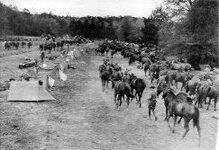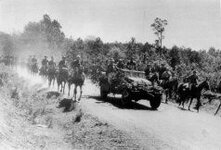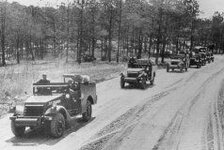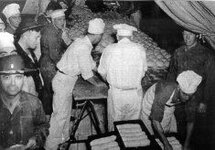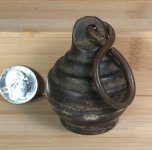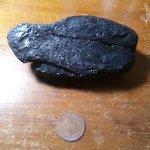- Jan 6, 2006
- 20,846
- 2,532
- 🏆 Honorable Mentions:
- 1
- Detector(s) used
- Garrett AT Pro, Ace 250 & Ace 400
- Primary Interest:
- All Treasure Hunting
There are thousands of stories told by local folks throughout Louisiana concerning the Great Louisiana Maneuvers. Even today, when visiting with the old timers, just sitting on the porch drinking coffee with them, invariably the conversation will come up about the Louisiana Maneuvers. The rural inhabitants of this section of Louisiana could not comprehend the vast number of troops and vehicles that invaded them during the maneuvers. One thing they all remember is the magnificent cavalry horses that were used by the mounted units and the big Missouri mules used by the field artillery units. B.D. (Bud) Robertson tells a story of a beautiful cavalry horse coming up the lane to their farm late one afternoon. The horse was running lickety-split, as fast as he could go, without a rider, but with full cavalry gear on him. Sometime later a dusty cavalryman, obviously a "Yankee" (who had no knowledge of the South or its insects) came trudging up and asked if his horse had came by and was told that it had. He replied that he had tied his horse to some bushes and that all of a sudden it was covered by "little yellow flies", which made his horse run away. Little did he know that he had stopped and dismounted on a yellow jacket nest and these little insects had stung his horse and made it run off! Later in the day he came trudging back with his mount in tow.
Robertson also tells of how late in the evening troopers from a cavalry unit camped next to his farm house and attempted to slip into his corn patch and cut corn stalks for the cavalry mounts. They were run-off, but remained camped in the area. Robertson also said that one of his most prized possessions as a youngster during the maneuvers was when he found a "cavalry hat" lying in the road, that had been knocked from a soldier's head during a night attack . It was his first hat, and he was proud of it!
Another story told by Robertson concerns a "chinaberry" tree at their farm that had a full crop of chinaberries on it. Several cavalrymen spied the tree, and thinking it was a fruit tree began to gather and eat large quantities of these berries. As he and his father approached, they overheard one of the cavalrymen tell the others that those are the worst tasting grapes he had ever eaten ! When told what they had eaten and that they were supposedly poisonous, all of them began spitting, sputtering, and coughing. Some wild grapes, weren't they!
The long columns of mounted cavalry traveled day and night, often stopping only to water their mounts. Residents remember seeing the cavalry horses in column with feed bags on their muzzles, eating oats and corn as they traveled. Many rural people tell of catching soldiers in their corn cribs trying to get additional corn for their mounts.
By the end of the Louisiana Maneuvers, the beloved cavalry mounts were being traded for mechanized vehicles. To the cavalryman, his mount was more dependable than a motor vehicle. A veteran cavalryman could saddle and place his equipment on his mount and be in formation in less than 3 ½ minutes. The mounted units of the U.S. Army had performed magnificently during the maneuvers but were being displaced by the fast mechanized units. The field artillery had big, strong Missouri mules used as pack transport; after being unloaded, the artillerymen then used the mules as mounts until they were needed again to transport cargo. There is still a large wild horse herd on Peason Ridge Military Reservation. As you view these wild horses, you can see the blood lines of the calvary horses o World War II in them. Many of the cavalry mounts, sick or lame, along with some who escaped, mixed with the wild horses roaming the Peason area and their descendants still roam freely.
To the soldiers, sometimes the maneuvers were a lark, sometimes it was frightening. Lt. John Eals of the 32nd Infantry Division of the BLUE Army remembers that everybody took it as just another training mission. No one thought we were really going to war. Men were more worried about coral snakes, ticks, and chiggers than anything else. During the 1941 Maneuvers for the first time, the coral snake was positively identified as being in Louisiana . A soldier camped out in the field east of Hornbeck on the edge of Peason Ridge failed to check his bedroll left in his pup tent and crawled in and went to sleep. A coral snake had crawled in and made his home there and bit the unsuspecting soldier as he slept. The soldiers comrades found him dead the next morning, with the coral snake still in the bedroll. There were other tragedies. The first day four men were killed in a traffic accident, in the next few days two more had died by drowning, two from disease, and five in a plane crash.
Local folks were understanding of maneuver damage, but was extremely wary of other damage by the troops. Troops foraged through corn field and corn cribs for extra food for their cavalry mounts, and vehicles knocked down farmers fences and damaged their crops. One farmer was quoted as saying that the army had taken all the redbugs out of the country and that they had cleared his land better than he ever could!
Don Stoker of Robeline tells of soldiers "borrowing" his father's prize possession, a mechanical hay mower and hooking it to the back of a jeep to clear a landing field for the small piper Cub "grasshopper" observation planes. These small and tiny Piper Cubs and other light observation planes could land in a pasture, taxi on a country road, and could be concealed under a tree, since they were so small. The soldiers who had Mr. Stoker's hay mower hit a survey marker and cracked the mower casing, spilling all he oil and destroying the mower. Mr. Stoker put in a claim for the damage and a "smart aleck" Army Captain came to discuss his claim. They began to argue over the cost of the mower, and the Captain started to leave. He turned and came back to Mr. Stoker and told him that the whole parish was trying to steal from the Army, and that Mr. Stoker was a "ragged, deadbeat farmer just like the rest." Mr. Stoker, a World War I veteran, hit the Captain so hard his feet flew off the ground and he was knocked cold. Later that evening, the Natchitoches Parish Sheriff and an Army officer came out and told Mr. Stoker he'd have to go to a hearing because he had broken the Captain's jaw. At the hearing, both the Captain's driver and his assistant testified as to how the Captain had provoked Mr. Stoker. After the hearing Mr. Stoker didn't have to go to jail and the Army paid his claim for damages on his mower!
There were incidents of soldiers turning out livestock so they could sleep in dry barns, of soldiers sleeping everywhere, even on the porches of peoples houses, of tearing down fences so that convoys could go through, and of burning all the wood farmers had cut and stacked for cooking, heating, and syrup making.
Don Marler recalls that so many soldiers stopped each day at their farm near Hineston for water that they would drain it completely. Each night the well would refill itself. Woodrow Herrington in the Peason Community would let the soldiers get water, but after a few days he had to cover his well. The soldiers would get water and then would wash and throw the soap into the well, nearly ruining it.
Scott DeBose of Many recalls that both sets of his grandparents lived near Many, just a few miles apart. He stated that one night the RED Army camped in one set of grandparents field, while the BLUE Army camped in the others field. The soldiers continually wanted water, so officers told one of his grandparents that the would have to put chlorine tablets in their well so that the water would be safe and purified. They put so much chlorine in the well that the well was ruined and his grandparents had to dig another one.
Some troops were short of food and water. Don Marler's family had a small truck farm near Seiper and they sold everything in the vegetable line to the soldiers and all the chickens but one hen who had 1 biddy(chick). He recalls selling slices of watermelon cut in four pieces, long way, to the soldiers. One soldier, a "Yankee" by his speech and actions, jumped from a truck and bought a watermelon. Instead of cutting the melon long ways, he just cut it in round slices. Don states that this was a culture shock, seeing him cut the melon wrong. He said his family talked about how silly that Yankee was for nearly a month.
Mr. Jennings Rogers who resides in the Mount Carmel Community recalled that he and his wife had made a trip in their automobile to Baton Rouge during the maneuvers and arrived back home late in the evening. He said that in view of his headlights, there were things moving up and down in his yard. When he got out, he found that what he had seen was soldiers helmets moving around. A large group had captured his house and had dug foxholes all over his yard, and that when the soldiers saw the headlights of his car, they would raise up and peek out of their foxholes at the approaching vehicle. He states that soldiers were camped everywhere, and that they asked if he would be kind enough to let them sleep on his porch and in the outbuildings of his farm, which he agreed to do.
Cheryl Perkins tells that there were so many soldiers around her mothers parents home that they actually had to step over the sleeping G.I.'s . Her mothers younger sisters would get their older brother to accompany them to the out house as a chaperon due to soldiers being everywhere. One thing everyone remembers though, is that the soldiers of this era were extremely polite and well mannered.
Inez Davis, who's husband was in the service, lived between Florien and Mount Carmel. The roads were so bad that the postal service could not bring the mail to the rural regions. She would walk six miles to the Florien post office to get her mail. She states she was never scared of any of the soldiers and that they were very well mannered.
Glen Herrington of the Peason Community remembers the canteens that set up near his home. The first chewing gum he ever got came from one of these mobile PX's that he said resembled an Air Stream trailer. The soldiers gave him candy, gum, and items from their rations to eat and to carry home.
Pershing Loftin and his family lived near DeRidder and were swamped at their farm by soldiers from the 36th Texas Infantry Division , a National Guard unit. This division during World War II had severe casualties at Anzio and in the Italian Campaign. The commanders of this unit set up their tents behind the Loftin's home, along with tents for some higher ranking officers in charge of the BLUE Army. Since there was no rural electrification at this time, water was still drawn by hand from the well. Mr. Loftin's grandson, Victor Townsley, was staying with them, and was hired by Colonel Dwight Eisenhower to daily draw water from the well, let it sit in the warm sun all day, then pour it into a tub in the nearby smokehouse for an evening bath. Other officers from the camp would also come and take a bath in the smokehouse when they had occasion to do so.
W.F.Herrington lived near Peason and one day some soldiers came and asked if they could borrow his wash pot. In these days a wash pot was of great value to a rural family. The soldiers stated they needed to wash some clothes and would bring the wash pot back. After several days, Mr. Herrington began to worry but late that evening the soldiers returned with the wash pot completely filled with field rations, the only payment the soldiers had.
Bud Robertson was befriended at a field kitchen and one day as a unit was about to move out the mess sergeant asked him if his family liked coffee. Coffee was a luxury and had been rationed for so long that no one could remember the last time they had real coffee at his house. Upon arriving home on his horse he found his family working in the fields. He told his father what a prize the mess sergeant had given him. His father told his wife to go home and start getting coffee water hot, that they were going to drink coffee till they were full !
Roy Cook, who resided southeast of Florien a few miles, stated he had given some of the southern soldiers camped near his home some sweet potatoes to eat. Later in the day, a soldier from "up north" came to Mr. Cook's house and told him the potatoes were very good , but would he take him out in the woods and show him some trees with "tater vines" growing up them so he could gather more of those good "taters".
The maneuvers of 1942, 1943, and 1944 were anti-climatic compared to the action and size of the 1941 war games. In 1941 tactics matched army versus army size units, with over 19 full divisions involved. However, in 1942 only 9 divisions were involved in mostly division versus division training. The maneuvers of 1943 and 1944 were hampered by severe weather conditions. An extremely severe winter storm hit the whole state of Louisiana breaking ice laden limbs, trees, and downing power lines. Troops were not prepared for this type of winter so far south. The troops did not have proper winter clothing and boots, and may cases of pneumonia, flu, colds, and even trench foot began appearing. As the ice and snow melted, all the roads turned into boggy quagmires, stopping all but a few military vehicles. One lady in the Peason Community began having labor pains during the 1943/44 maneuvers. Being unable to get over the roads due to their impassable conditions, her husband asked some soldiers in a medical unit camped near his house if they would attempt to get her to the hospital in Many. They loaded her in a half-track and headed for Many. However, in a few miles the road worsened, and at Mount Carmel the half-track became stuck deeply in the mud. The medics in the half-track delivered a big bouncing baby boy while stuck in the mud!
Today there is almost no sign left of the Great Maneuvers, other than just a few lonely foxholes or tank positions. As you scratch around these old battle positions you can still find cartridge casings and the remains of old ration cans.
In the Command Performance Radio Program broadcast by Bing Crosby on V-J Day 1945, he mentioned that the war for the United States actually began in Louisiana where all the maneuver battles had been fought. And in a scene from the World War II movie, "A Walk in the Sun," when the soldiers are asked to take a farmhouse held by the Germans, one soldier comments that as bad as the fighting might get, "it can't be worse than the Louisiana Maneuvers." The men who came to Louisiana and fought the mock battles never forgot these experiences.
Encampment of cavalry troops near Dowden Creek in northern Vernon Parish located on present day Peason Ridge Military Reservation. Note the pup tents for the troopers and the picket line of cavalry mounts.
Robertson also tells of how late in the evening troopers from a cavalry unit camped next to his farm house and attempted to slip into his corn patch and cut corn stalks for the cavalry mounts. They were run-off, but remained camped in the area. Robertson also said that one of his most prized possessions as a youngster during the maneuvers was when he found a "cavalry hat" lying in the road, that had been knocked from a soldier's head during a night attack . It was his first hat, and he was proud of it!
Another story told by Robertson concerns a "chinaberry" tree at their farm that had a full crop of chinaberries on it. Several cavalrymen spied the tree, and thinking it was a fruit tree began to gather and eat large quantities of these berries. As he and his father approached, they overheard one of the cavalrymen tell the others that those are the worst tasting grapes he had ever eaten ! When told what they had eaten and that they were supposedly poisonous, all of them began spitting, sputtering, and coughing. Some wild grapes, weren't they!
A scout car passing a column of mounted cavalry showing the new concept of the horse/mechanized unites being tried by the Army during the maneuvers. These units were operating between Plainview and Hornbeck in south Sabine Parish.
The long columns of mounted cavalry traveled day and night, often stopping only to water their mounts. Residents remember seeing the cavalry horses in column with feed bags on their muzzles, eating oats and corn as they traveled. Many rural people tell of catching soldiers in their corn cribs trying to get additional corn for their mounts.
Column of armored scout cars advancing through Sabine Parish during the 1941 Louisiana Maneuvers.
By the end of the Louisiana Maneuvers, the beloved cavalry mounts were being traded for mechanized vehicles. To the cavalryman, his mount was more dependable than a motor vehicle. A veteran cavalryman could saddle and place his equipment on his mount and be in formation in less than 3 ½ minutes. The mounted units of the U.S. Army had performed magnificently during the maneuvers but were being displaced by the fast mechanized units. The field artillery had big, strong Missouri mules used as pack transport; after being unloaded, the artillerymen then used the mules as mounts until they were needed again to transport cargo. There is still a large wild horse herd on Peason Ridge Military Reservation. As you view these wild horses, you can see the blood lines of the calvary horses o World War II in them. Many of the cavalry mounts, sick or lame, along with some who escaped, mixed with the wild horses roaming the Peason area and their descendants still roam freely.
To the soldiers, sometimes the maneuvers were a lark, sometimes it was frightening. Lt. John Eals of the 32nd Infantry Division of the BLUE Army remembers that everybody took it as just another training mission. No one thought we were really going to war. Men were more worried about coral snakes, ticks, and chiggers than anything else. During the 1941 Maneuvers for the first time, the coral snake was positively identified as being in Louisiana . A soldier camped out in the field east of Hornbeck on the edge of Peason Ridge failed to check his bedroll left in his pup tent and crawled in and went to sleep. A coral snake had crawled in and made his home there and bit the unsuspecting soldier as he slept. The soldiers comrades found him dead the next morning, with the coral snake still in the bedroll. There were other tragedies. The first day four men were killed in a traffic accident, in the next few days two more had died by drowning, two from disease, and five in a plane crash.
Local folks were understanding of maneuver damage, but was extremely wary of other damage by the troops. Troops foraged through corn field and corn cribs for extra food for their cavalry mounts, and vehicles knocked down farmers fences and damaged their crops. One farmer was quoted as saying that the army had taken all the redbugs out of the country and that they had cleared his land better than he ever could!
Don Stoker of Robeline tells of soldiers "borrowing" his father's prize possession, a mechanical hay mower and hooking it to the back of a jeep to clear a landing field for the small piper Cub "grasshopper" observation planes. These small and tiny Piper Cubs and other light observation planes could land in a pasture, taxi on a country road, and could be concealed under a tree, since they were so small. The soldiers who had Mr. Stoker's hay mower hit a survey marker and cracked the mower casing, spilling all he oil and destroying the mower. Mr. Stoker put in a claim for the damage and a "smart aleck" Army Captain came to discuss his claim. They began to argue over the cost of the mower, and the Captain started to leave. He turned and came back to Mr. Stoker and told him that the whole parish was trying to steal from the Army, and that Mr. Stoker was a "ragged, deadbeat farmer just like the rest." Mr. Stoker, a World War I veteran, hit the Captain so hard his feet flew off the ground and he was knocked cold. Later that evening, the Natchitoches Parish Sheriff and an Army officer came out and told Mr. Stoker he'd have to go to a hearing because he had broken the Captain's jaw. At the hearing, both the Captain's driver and his assistant testified as to how the Captain had provoked Mr. Stoker. After the hearing Mr. Stoker didn't have to go to jail and the Army paid his claim for damages on his mower!
There were incidents of soldiers turning out livestock so they could sleep in dry barns, of soldiers sleeping everywhere, even on the porches of peoples houses, of tearing down fences so that convoys could go through, and of burning all the wood farmers had cut and stacked for cooking, heating, and syrup making.
Don Marler recalls that so many soldiers stopped each day at their farm near Hineston for water that they would drain it completely. Each night the well would refill itself. Woodrow Herrington in the Peason Community would let the soldiers get water, but after a few days he had to cover his well. The soldiers would get water and then would wash and throw the soap into the well, nearly ruining it.
Scott DeBose of Many recalls that both sets of his grandparents lived near Many, just a few miles apart. He stated that one night the RED Army camped in one set of grandparents field, while the BLUE Army camped in the others field. The soldiers continually wanted water, so officers told one of his grandparents that the would have to put chlorine tablets in their well so that the water would be safe and purified. They put so much chlorine in the well that the well was ruined and his grandparents had to dig another one.
Some troops were short of food and water. Don Marler's family had a small truck farm near Seiper and they sold everything in the vegetable line to the soldiers and all the chickens but one hen who had 1 biddy(chick). He recalls selling slices of watermelon cut in four pieces, long way, to the soldiers. One soldier, a "Yankee" by his speech and actions, jumped from a truck and bought a watermelon. Instead of cutting the melon long ways, he just cut it in round slices. Don states that this was a culture shock, seeing him cut the melon wrong. He said his family talked about how silly that Yankee was for nearly a month.
Mr. Jennings Rogers who resides in the Mount Carmel Community recalled that he and his wife had made a trip in their automobile to Baton Rouge during the maneuvers and arrived back home late in the evening. He said that in view of his headlights, there were things moving up and down in his yard. When he got out, he found that what he had seen was soldiers helmets moving around. A large group had captured his house and had dug foxholes all over his yard, and that when the soldiers saw the headlights of his car, they would raise up and peek out of their foxholes at the approaching vehicle. He states that soldiers were camped everywhere, and that they asked if he would be kind enough to let them sleep on his porch and in the outbuildings of his farm, which he agreed to do.
Cheryl Perkins tells that there were so many soldiers around her mothers parents home that they actually had to step over the sleeping G.I.'s . Her mothers younger sisters would get their older brother to accompany them to the out house as a chaperon due to soldiers being everywhere. One thing everyone remembers though, is that the soldiers of this era were extremely polite and well mannered.
Inez Davis, who's husband was in the service, lived between Florien and Mount Carmel. The roads were so bad that the postal service could not bring the mail to the rural regions. She would walk six miles to the Florien post office to get her mail. She states she was never scared of any of the soldiers and that they were very well mannered.
Glen Herrington of the Peason Community remembers the canteens that set up near his home. The first chewing gum he ever got came from one of these mobile PX's that he said resembled an Air Stream trailer. The soldiers gave him candy, gum, and items from their rations to eat and to carry home.
Pershing Loftin and his family lived near DeRidder and were swamped at their farm by soldiers from the 36th Texas Infantry Division , a National Guard unit. This division during World War II had severe casualties at Anzio and in the Italian Campaign. The commanders of this unit set up their tents behind the Loftin's home, along with tents for some higher ranking officers in charge of the BLUE Army. Since there was no rural electrification at this time, water was still drawn by hand from the well. Mr. Loftin's grandson, Victor Townsley, was staying with them, and was hired by Colonel Dwight Eisenhower to daily draw water from the well, let it sit in the warm sun all day, then pour it into a tub in the nearby smokehouse for an evening bath. Other officers from the camp would also come and take a bath in the smokehouse when they had occasion to do so.
W.F.Herrington lived near Peason and one day some soldiers came and asked if they could borrow his wash pot. In these days a wash pot was of great value to a rural family. The soldiers stated they needed to wash some clothes and would bring the wash pot back. After several days, Mr. Herrington began to worry but late that evening the soldiers returned with the wash pot completely filled with field rations, the only payment the soldiers had.
An army field kitchen making loaves of "maneuver bread". These kitchens made hundreds and hundreds of loaves of this bread each day for the units participating in the Louisiana Maneuvers
. Bud Robertson was befriended at a field kitchen and one day as a unit was about to move out the mess sergeant asked him if his family liked coffee. Coffee was a luxury and had been rationed for so long that no one could remember the last time they had real coffee at his house. Upon arriving home on his horse he found his family working in the fields. He told his father what a prize the mess sergeant had given him. His father told his wife to go home and start getting coffee water hot, that they were going to drink coffee till they were full !
Roy Cook, who resided southeast of Florien a few miles, stated he had given some of the southern soldiers camped near his home some sweet potatoes to eat. Later in the day, a soldier from "up north" came to Mr. Cook's house and told him the potatoes were very good , but would he take him out in the woods and show him some trees with "tater vines" growing up them so he could gather more of those good "taters".
The maneuvers of 1942, 1943, and 1944 were anti-climatic compared to the action and size of the 1941 war games. In 1941 tactics matched army versus army size units, with over 19 full divisions involved. However, in 1942 only 9 divisions were involved in mostly division versus division training. The maneuvers of 1943 and 1944 were hampered by severe weather conditions. An extremely severe winter storm hit the whole state of Louisiana breaking ice laden limbs, trees, and downing power lines. Troops were not prepared for this type of winter so far south. The troops did not have proper winter clothing and boots, and may cases of pneumonia, flu, colds, and even trench foot began appearing. As the ice and snow melted, all the roads turned into boggy quagmires, stopping all but a few military vehicles. One lady in the Peason Community began having labor pains during the 1943/44 maneuvers. Being unable to get over the roads due to their impassable conditions, her husband asked some soldiers in a medical unit camped near his house if they would attempt to get her to the hospital in Many. They loaded her in a half-track and headed for Many. However, in a few miles the road worsened, and at Mount Carmel the half-track became stuck deeply in the mud. The medics in the half-track delivered a big bouncing baby boy while stuck in the mud!
Today there is almost no sign left of the Great Maneuvers, other than just a few lonely foxholes or tank positions. As you scratch around these old battle positions you can still find cartridge casings and the remains of old ration cans.
In the Command Performance Radio Program broadcast by Bing Crosby on V-J Day 1945, he mentioned that the war for the United States actually began in Louisiana where all the maneuver battles had been fought. And in a scene from the World War II movie, "A Walk in the Sun," when the soldiers are asked to take a farmhouse held by the Germans, one soldier comments that as bad as the fighting might get, "it can't be worse than the Louisiana Maneuvers." The men who came to Louisiana and fought the mock battles never forgot these experiences.

